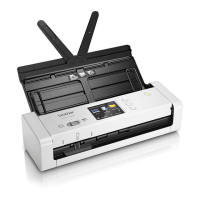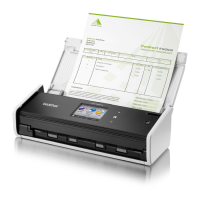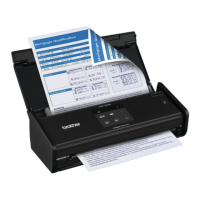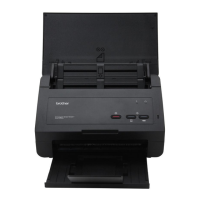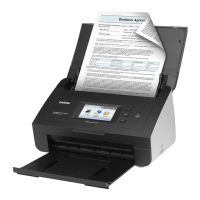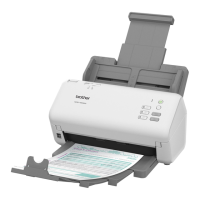Do you have a question about the Brother ADS-1250W and is the answer not in the manual?
Explains symbols, conventions, and notes used in the guide.
Lists registered and unregistered trademarks of various companies.
Provides essential usage advice, product updates, and country-specific information.
Identifies and labels the main components of the scanner.
Step-by-step instructions for preparing the scanner for use.
Describes the buttons and indicators on the control panel.
Details the functions accessible via the touchscreen display.
Explains the types and usage of USB ports and cables.
Lists acceptable document types, sizes, and thicknesses.
Instructions for loading various types of documents into the ADF.
Checks and requirements before initiating a scan.
How to scan using power from a computer's USB port.
Explains various scanning destinations and methods from the machine.
How to scan documents using Windows applications.
How to scan documents using Mac applications.
Table detailing network feature support across operating systems.
Information on utilities for network configuration.
Detailed wireless setup procedures.
Configuration of advanced network functionalities.
Specific details like error codes for network issues.
How to prevent unauthorized access to machine settings.
Measures to secure network communications and access.
General introduction to the Brother iPrint&Scan application.
Steps to set up custom scan workflows via the app.
Explains common error messages and their causes/actions.
Interpreting the machine's indicator lights for errors.
Procedures for clearing paper jams.
Procedures for clearing card jams.
General troubleshooting guide and problem-solving tips.
Instructions on how to find the machine's serial number.
Steps to reset network and other machine settings.
How to reset counters after replacing parts.
Instructions for cleaning the scanner and machine parts.
Information on replacing consumable parts like rollers.
Guidance on safely packing the machine for transport.
How to adjust settings directly on the machine's interface.
How to adjust settings using PC-based utilities.
Technical details and performance specifications of the machine.
How to input text using the touchscreen keyboard.
Explains symbols, conventions, and notes used in the guide.
Lists registered and unregistered trademarks of various companies.
Provides essential usage advice, product updates, and country-specific information.
Identifies and labels the main components of the scanner.
Step-by-step instructions for preparing the scanner for use.
Describes the buttons and indicators on the control panel.
Details the functions accessible via the touchscreen display.
Explains the types and usage of USB ports and cables.
Lists acceptable document types, sizes, and thicknesses.
Instructions for loading various types of documents into the ADF.
Checks and requirements before initiating a scan.
How to scan using power from a computer's USB port.
Explains various scanning destinations and methods from the machine.
How to scan documents using Windows applications.
How to scan documents using Mac applications.
Table detailing network feature support across operating systems.
Information on utilities for network configuration.
Detailed wireless setup procedures.
Configuration of advanced network functionalities.
Specific details like error codes for network issues.
How to prevent unauthorized access to machine settings.
Measures to secure network communications and access.
General introduction to the Brother iPrint&Scan application.
Steps to set up custom scan workflows via the app.
Explains common error messages and their causes/actions.
Interpreting the machine's indicator lights for errors.
Procedures for clearing paper jams.
Procedures for clearing card jams.
General troubleshooting guide and problem-solving tips.
Instructions on how to find the machine's serial number.
Steps to reset network and other machine settings.
How to reset counters after replacing parts.
Instructions for cleaning the scanner and machine parts.
Information on replacing consumable parts like rollers.
Guidance on safely packing the machine for transport.
How to adjust settings directly on the machine's interface.
How to adjust settings using PC-based utilities.
Technical details and performance specifications of the machine.
How to input text using the touchscreen keyboard.
| Bundled software | Nuance PaperPort SE with OCR for Windows, Brother iPrint&Scan, Power PDF |
|---|---|
| AC adapter included | Yes |
| Quantity per pack | 1 pc(s) |
| Wi-Fi standards | 802.11b, 802.11g, Wi-Fi 4 (802.11n) |
| Security algorithms | 64-bit WEP, 128-bit WEP, WPA-PSK, WPA2-PSK |
| Mobile printing technologies | Brother iPrint & Scan |
| Supported network protocols (IPv4) | DHCP, APIPA (Auto IP), WINS/NetBIOS name resolution, DNS Resolver, mDNS, SNMPv1/v2c, ICMP |
| Scan to | Cloud, E-mail, File, Image, OCR, USB |
| Sensor type | Dual CIS |
| Scan drivers | ICA, SANE, TWAIN, WIA |
| Internal memory | 512 MB |
| Scan file formats | BMP, JPEG, JPG, PDF, PNG, TIFF |
| Daily duty cycle (max) | 1000 pages |
| Power supply type | DC |
| AC input frequency | 50 - 60 Hz |
| Power consumption (off) | 0.1 W |
| Power consumption (sleep) | 1.6 W |
| Power consumption (typical) | 9 W |
| Sustainability certificates | ENERGY STAR |
| Linear (1D) barcodes supported | Codabar, Code 128, Code 39, Code 93, EAN-13, EAN-8, GS1-128 (UCC/EAN-128), PDF417 |
| Grayscale levels | 256 |
| Input color depth | 48 bit |
| Maximum scan size | 215.9 x 863 mm |
| Output color depth | 24 bit |
| Output monochrome depth | 1 bit |
| Enhanced scan resolution | 1200 x 1200 DPI |
| Optical scanning resolution | 600 x 600 DPI |
| Duplex ADF scan speed (b/w, A4) | 50 ipm |
| USB version | 3.2 Gen 1 (3.1 Gen 1) |
| USB connector type | Micro-USB B |
| Standard interfaces | USB 3.2 Gen 1 (3.1 Gen 1), Wireless LAN |
| Mac operating systems supported | Mac OS X 10.11 El Capitan, Mac OS X 10.12 Sierra, Mac OS X 10.13 High Sierra |
| Server operating systems supported | Windows Server 2008 R2, Windows Server 2012, Windows Server 2012 R2, Windows Server 2016 |
| Windows operating systems supported | Windows 10, Windows 7, Windows 8, Windows 8.1 |
| Card thickness (max) | 1.24 mm |
| Scanning media types supported | Business Card, Plain paper, Plastic Card, Recycled paper, Thick paper, Thin paper |
| Maximum ISO A-series paper size | - |
| Storage temperature (T-T) | 0 - 40 °C |
| Operating temperature (T-T) | 5 - 35 °C |
| Storage relative humidity (H-H) | 10 - 90 % |
| Operating relative humidity (H-H) | 20 - 80 % |
| Auto document feeder (ADF) input capacity | 20 sheets |
| Online services supported | Dropbox, Google Drive, OneDrive |
| Scanner type | Sheet-fed scanner |
| Product color | Black, White |
| Depth | 104 mm |
|---|---|
| Width | 300 mm |
| Height | 84 mm |
| Weight | 1800 g |
